* * *
Most of the pickled vegetables sold in present-day Japan contain various additives, from sweeteners such as stevia and licorice to coloring agents. Pickles were the ancestral wisdom of the Japanese, as pressing vegetables together with salt, miso, and other seasonings had the effect of increasing the strong lactic acid naturally found on the surface of the vegetables, thereby adding depth to the flavor and improving preservability. But today, instant pickles are taking over that are made with chemical additives without the use of weights. What developed as a preserved food now occasionally comes with preservatives, such as sorbic acid.
Meanwhile, there are people in various areas of Japan who continue to make traditional pickles free of additives using vegetables that are unique to the local climate and soil.
A Vegetable Work of Art and Labor
The history of turnip in Japan is older than that of the daikon radish, presumably having been imported via China by the eighth century. In some parts of Japan yukina, or turnip stalks, are pickled as a valuable source of nutrition during the long winter, as exemplified in the fusube-zuke of the Kami-Nagai district of Yonezawa-shi, Yamagata Prefecture. Fusube pickles are juicy, faintly sweet, and have a crisp and pungent aftertaste. Its profound yet delicate savor, which evokes the image of snowflakes accumulating into a thick carpet of white, has no equal.
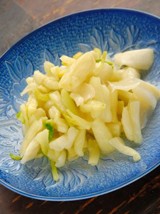
Yukina is a precious food, as only a small portion of the vegetable is eaten and much work goes into its cultivation. The turnips are transplanted at the end of fall after they have developed flower stalks, and later, the thick white spears nourished by the old leaves under cover of snow are harvested for consumption. Vegetables that have grown white in the snow due to lack of sunlight are called nanpaku yasai, or blanched (etiolated) vegetables. While other parts of Japan also have leafy vegetables known as yukina, meaning "snow vegetable," none of these are cultivated under the snow.
The turnip stalks of Kami-Nagai were given the name yukina in 1931 when introducing them to the Tokyo market. Until then they were locally known as kabu-no-to or Nagaoka-na, leading the locals to simultaneously believe in two hypotheses regarding the origin of the vegetable. One traces its ancestry to the Toyama- kabu (named after the Kami-Nagai Toyama district), allegedly introduced to Yonezawa about 400 years ago from Echigo by the Uesugi family, which once ruled the area. The other story has it that yukina is related to the Nagaoka-na, a natural hybrid between the taisai that was imported from China beginning in the Meiji era (1912-1926) and local vegetables. In 2004, Assistant Professor Hiroaki Egashira of the Yamagata University Faculty of Agriculture conducted a DNA analysis, revealing that yukina is indeed a close relative of both the Toyama- kabu and the Nagaoka- na . Egashira speculates that the Toyama- kabu initially interbred with some other vegetable, then further hybridized with the Nagaoka- na in the Meiji era onward.
Originally brought into the region as a valuable winter vegetable that can survive the heavy snow, yukina was cultivated in an extremely limited area of only about 150 homes in the Kami-Nagai district. Today around 100 households grow it, largely for their own consumption, but only 11 of them produce it on a commercial basis. The decline is due to the immense labor involved in growing yukina, coupled with the fact that, despite all the hard work, a large part of the vegetables must be discarded to ensure quality, resulting in a yield of only about 25 percent. The extreme weather of recent years may be another factor.
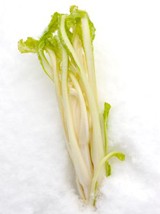
Given the value placed on efficiency today, the relish of yukina is all the more rare and precious. The spears freshly dug from under the snow are a translucent yellow green. When Shoichi Yoshida, one of the producers, was asked by a customer about the health value of yukina, he replied: "It's grown under the snow, so the nutritional value may not come to much if you were to tabulate it all. But I think its very vitality-the fact that it can grow under the snow-says enough."
Takashi Aoba, a pioneer in studies of traditional vegetables, is said to have extolled yukina as "a work of art in the vegetable world." Both yukina and the fusube-zuke made with it can only be eaten for a short period each year, from the end of December to the end of February. Though usually pickled, yukina is just as good fresh, being crisp to the tooth and subtly bittersweet. Pickled or fresh, its savor is in a league of its own.
From Seed to Pickle
A cursory look at the yukina field at harvest time tells us nothing of the labor and toil involved in growing the vegetable. The process, which begins with seeding in summer and ends with harvesting in winter, is roughly as follows, as practiced by the Yoshida family.
First, the seeds are harvested in May. Cruciferous vegetables crossbreed easily, as evidenced by the great variety of vegetables of this family in Japan, including the Chinese cabbage, daikon, takana, and nozawana . The seeds are therefore carefully harvested inside a greenhouse. They are then sown between late August and early September in an open field.
In late November the plants, by now about 60 to 80 centimeters tall, are transplanted in a procedure known as tokoyose . They are wrapped and covered with soil, straw, newspaper, and plastic sheets for protection from the cold.
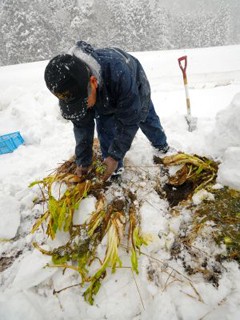
The yukina is dug up from under the snow between the end of December and the end of February to harvest the flower stalks. The withered old leaves, having given all their nutrients to the vigorous growth of the stalks, are removed, as are any broken and discolored leaves. After paring off the excess, all that is left to be eaten amounts to only a fourth or fifth of the entire plant. Better product quality means a considerably lower yield.
In 2007, moreover, the yukina was hit by frost just before tokoyose . The plants wilted, resulting in poorer growth compared to other years and shorter shoots. "The yield is much lower than usual, and we don't know if we'll have enough to meet all the orders," Yoshida said with concern.
The difficulty of growing yukina does not end here. What with the heavy snowfall, harvesting yukina requires a large industrial snowplow. Each day, just enough yukina to be pickled and shipped that day is harvested by plowing paths in the vast blanket of snow covering the field.
Making the fusube-zuke is an equally laborious and delicate task. It takes skill and experience, as the wrong amount of salt or duration of boiling can prevent the characteristic sharpness from coming out. Yoshida shares the task with his wife: Every day they harvest about 15 to 20 kilograms of yukina, which they immediately process and pickle.
To harvest, Yoshida must dig up the yukina from the snow, which can grow more than 150 centimeters deep in some years, taking care not to hurt the plants. Withered leaves are stripped on the spot, leaving only the young white shoots.
After rinsing them well in running water and cutting off the roots and leaves, the shoots are chopped into two-centimeter pieces. Brown and worm-eaten parts are all removed, as even the slightest black spots are highly conspicuous on the white vegetable.
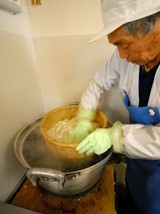
Next, the chopped yukina is put into a specially made colander and parboiled about three times for three to five seconds each. It is this process, described by the verb fusuberu in the local dialect, that draws out the sharp aftertaste of fusube-zuke . But it is also hard on the back, as the heavy colander must be repeatedly lowered and lifted.
The boiled yukina is cooled in plenty of running water, then mixed with salt amounting to two percent of its fresh weight. Finally, the mixture is sealed in a plastic bag, put into a container, and pressed with a weight. Three or four days of pickling will give rise to a hint of sweetness as well as a piquant aftertaste, a complexity that cannot be found in artificially made pickles.
Value Old and New
Uesugi Yozan (1751-1822) of the Yonezawa domain, who is remembered as an able governor, is said to have promoted yukina as a winter vegetable. Given its heavy snowfall, the region had little in the way of vegetables during the winter. Yukina, with its ability to grow even in the snow, came to be widely grown as a valuable source of nutrition for farmers.
Today yukina is only grown in the Kami-Nagai district at the foot of the gently sloping Mt. Nadera. About 100 out of the 150 households grow yukina for home consumption, and 11 farms belonging to the Yonezawa-shi Kami-Nagai Growers' Association ship a total of eight to ten tons per year. Only 3 of the 11 farms also produce fuzube-zuke .
While the entire Yonezawa region receives heavy snowfall, the Kami-Nagai district is particularly known for deep snow cover due to its mountainside location. The ideal depth of snow for yukina cultivation is from 70 to 100 centimeters, a condition that is to be found in Kami-Nagai, although the snow occasionally reaches 150 centimeters. A comfortable temperature is maintained under the snow thanks to respiration of the plants, allowing new shoots to grow with nourishment from older leaves. In Yoshida's words, "The exquisite taste of yukina comes from being wrapped in a warm futon of snow."
Climatic anomalies in recent years have led, however, to fluctuating snow levels. Too much snow makes harvesting a backbreaking labor, while too little can spoil the yukina .
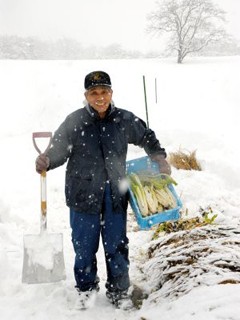
The pebbly clay soil of Kami-Nagai also makes the area ideal for the cultivation of cruciferous vegetables. Transplanting the yukina in the fall is hard work, as the soil clings heavily to the shoes. But the vegetable does not grow at all in volcanic soil, according to Yoshida.
The rounded part of the turnip plant that we typically think of as the root is called the hypocotyl, and the root is actually only the wispy portion extending from its tip. The custom of growing turnips for the stalks rather than the hypocotyls and of pickling the stalks is seen across Japan, as with the nozawana of Nagano Prefecture. But each is different from the others, and the yukina has a distinct flavor and texture without parallel. In the face of globalizing forces that are making the same tastes and vegetables available the world over, the unique savor of these traditional vegetables is an increasingly valuable heritage.
In its native region, yukina is primarily eaten in the form of fusube-zuke . The pickle goes well with uchimame (beaten soybeans) and is an essential ingredient in hiyashiru, a local specialty made with shiitake mushrooms and herring roe that is eaten during the New Year holidays.
Meanwhile, the " shabu-shabu of fresh yukina and pork," a recipe that Yoshida learned from Masayuki Okuda, the chef and owner of an Italian restaurant called Al Ché-cciano, was stunningly delicious as well. The yukina 's pungency is drawn out by briefly boiling it and sealing it in a plastic bag, and the nutty aroma coupled with its crunchy texture is particularly pleasing. It also goes extremely well with pork. In addition to its traditional value as a pickled vegetable, yukina faces a bright future as a fresh vegetable yet to be explored.
Photos: Kazuo Kikuchi
